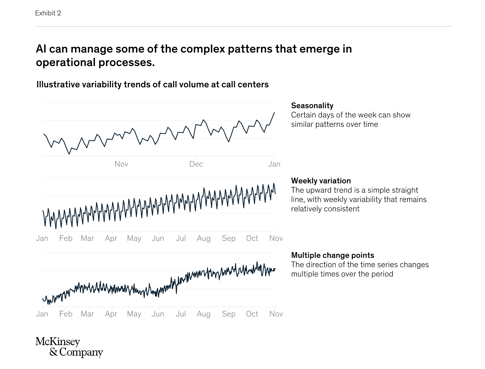Benefits of AI in Retail Demand Forecasting
Benefits of AI in Retail Demand Forecasting
Accurately predicting consumer demand has always been a cornerstone of successful retail operations. However, traditional forecasting methods often fall short in delivering the precision needed for effective decision-making.
Predictive analytics offers a powerful solution by leveraging advanced algorithms and vast datasets to provide precise demand forecasts. This approach enables retailers to optimize inventory, reduce costs, and enhance customer satisfaction, ultimately driving better business outcomes.
Quick Takeaways
- Predictive analytics improves demand forecast accuracy, helping retailers optimize inventory and reduce stock-related issues.
- Real-time data insights from predictive analytics empower retailers to make better, more informed decisions.
- Predictive analytics reduces costs by minimizing excess inventory and streamlining supply chain operations.
- By personalizing offerings based on demand forecasts, retailers can enhance customer satisfaction and loyalty.
Understanding Predictive Analytics
What is Predictive Analytics?
Predictive analytics is a forward-looking approach that utilizes historical data, machine learning algorithms, and statistical techniques to forecast future outcomes.
Unlike traditional methods that rely on past sales trends and human intuition, predictive analytics analyzes large datasets to identify patterns and trends that are not immediately apparent. However, the complexity of this analysis can be heightened by factors such as varying seasonality patterns and inconsistent trends over time, which are common in retail operations.
AI-driven predictive analytics addresses these challenges by adapting to these complex patterns, even in situations where historical data may be limited, thereby providing more accurate and actionable forecasts.

By integrating AI into decision-making processes, businesses can move beyond gut feelings and instead rely on data-backed insights to guide their strategies. This shift not only enhances the accuracy of decisions, but also increases the speed and efficiency with which they are made.
Key Benefits of AI-Driven Decision Making
Enhanced Accuracy and Precision
One of the most significant advantages of AI-driven decision making is its ability to enhance accuracy and precision. This is evident in the growing adoption of AI, with 77% of companies either using or exploring AI, and 83% claiming it as a top priority in their business plans.

The Role of AI in Predictive Analytics
Artificial Intelligence (AI) plays a crucial role in enhancing the capabilities of predictive analytics. AI algorithms process vast amounts of data more quickly and accurately than manual methods, allowing for real-time analysis and continuous learning.
By integrating AI, predictive analytics becomes capable of managing complex variables like seasonality and fluctuating trends, ensuring that demand forecasts remain relevant and precise. This adaptability is vital for retailers aiming to optimize their operations and respond proactively to market shifts, ultimately driving better business outcomes.
The Benefits of Predictive Analytics in Retail Demand Forecasting
1. Enhanced Forecast Accuracy
Predictive analytics significantly improves the accuracy of demand forecasts by analyzing a vast array of data points, including:
- Historical sales
- Market trends
- Consumer behavior patterns
This level of precision helps retailers anticipate demand more accurately, reducing the risk of stockouts and overstock situations. As a result, businesses can optimize their inventory levels, ensuring that they have the right products available at the right time to meet customer demand.
2. Improved Decision-Making
With the insights provided by predictive analytics, retailers can make more informed decisions across various aspects of their operations. Real-time data allows for dynamic adjustments to pricing strategies, promotional activities, and inventory management.
This proactive approach not only enhances operational efficiency but also enables retailers to capitalize on emerging trends and market opportunities, leading to better overall business performance.
3. Cost Reduction and Operational Efficiency
By reducing the likelihood of excess inventory and stockouts, predictive analytics helps retailers minimize waste and lower storage costs.
Additionally, accurate demand forecasting streamlines supply chain operations, reducing the need for last-minute adjustments and emergency shipments. This efficiency leads to significant cost savings, allowing retailers to allocate resources more effectively and improve their bottom line.
AI-driven demand forecasting can reduce supply chain errors by 20% to 50%, leading to a 65% boost in operational efficiency due to fewer lost sales and unavailable products. Moreover, industries have found that AI forecasting engines can automate up to 50% of workforce-management tasks, resulting in cost reductions of 10% to 15% while gradually improving hiring decisions and operational resilience.

These combined benefits highlight the transformative impact of predictive analytics on both operational and financial performance in the retail sector.
4. Personalization and Customer Satisfaction
Predictive analytics also plays a crucial role in enhancing the customer experience. By understanding consumer preferences and purchasing behavior, retailers can tailor their offerings to meet individual customer needs.
This personalization extends to targeted promotions, product recommendations, and optimized pricing strategies, all of which contribute to higher customer satisfaction and loyalty. When customers consistently find what they want, when they want it, they are more likely to return, driving repeat business and long-term success.
This trend underscores the urgency for retailers to embrace predictive analytics to maintain their competitive edge.
1. Ensure Data Quality
Begin by establishing robust data management practices to ensure access to clean, high-quality data. Accurate predictions rely on reliable data, so it’s essential to address any issues related to data cleanliness, completeness, and consistency.
2. Select the Right Tools and Platforms
Choose predictive analytics tools and platforms that offer scalability, ease of integration, and real-time data processing capabilities. Consider solutions like Hypersonix’s AI-driven platform, which is designed to meet the needs of modern retailers.
3. Involve Stakeholders
Engage all relevant stakeholders in the implementation process. This includes training staff on how to use the tools effectively and communicating the benefits of predictive analytics to ensure buy-in across the organization.
4. Provide Ongoing Support and Maintenance
Ensure continuous support and maintenance of the predictive analytics system to keep it functioning optimally. Regular updates and monitoring will help maintain data accuracy and relevance, adapting to changes in consumer behavior and market conditions.
Addressing Key Implementation Challenges
Data Integration
Challenge: Retailers often use multiple systems for inventory, sales, and customer data, making integration into a single predictive analytics platform complex.
Solution: Work with experienced vendors who can guide you through the integration process. Leveraging their expertise can help streamline the integration and ensure that all relevant data sources are accurately connected to the predictive analytics platform.
Ensuring Data Quality
Challenge: Predictive analytics relies heavily on the quality of the data it processes. Inaccurate or incomplete data can lead to flawed predictions.
Solution: Implement rigorous data cleaning and standardization processes before feeding data into the analytics platform. Continuously monitor and update your data to reflect changes in consumer behavior and market conditions, ensuring the analytics remain accurate and relevant.
Aligning Predictive Analytics with Business Goals
Challenge: Predictive analytics can only be effective if it is closely aligned with your overall business strategy and objectives.
Solution: Clearly define your business goals and ensure that your use of predictive analytics supports these objectives. This alignment will help make the insights generated by the analytics actionable and relevant, ultimately leading to better business outcomes.
Discover the Advantage of Predictive Analytics with Hypersonix
Incorporating predictive analytics into retail demand forecasting offers significant benefits, from enhanced accuracy and improved decision-making to cost reduction and increased customer satisfaction. By addressing key implementation challenges and aligning the technology with business goals, retailers can unlock the full potential of predictive analytics.
Discover how Hypersonix’s predictive analytics solutions can enhance your retail demand forecasting and drive success. Book a demo today to start optimizing your inventory and improving decision-making!







